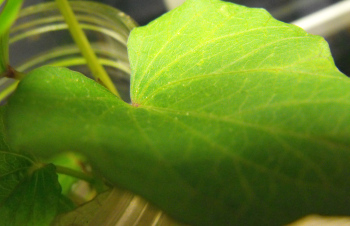
Sweet potato oedema
 When I see a problem with one of my plants, my
first thought is, "Okay, is this caused by a bacterium, fungus, or
insect?" It took me half an hour on Monday to realize that the
white specks on the upper leaves of my sweet potato slips were none of
the above.
When I see a problem with one of my plants, my
first thought is, "Okay, is this caused by a bacterium, fungus, or
insect?" It took me half an hour on Monday to realize that the
white specks on the upper leaves of my sweet potato slips were none of
the above.
The Cornell
University Plant Disease Diagnostic Clinic resolved my mystery:
Oedema
occurs when roots take up water faster than it can be used by the plant
or transpired through the leaves. Water pressure then builds up in the
mesophyll or internal cells of the leaf causing them to enlarge and
form tiny swollen blisterlike areas....
Oedema is most prevalent in the late winter especially during extended periods of cool, cloudy weather. It is likely to develop when the soil is warm and moist and the air is cool and moist. This environment results in rapid water absorption from the soil and slow water loss from the leaves.
Oedema is most prevalent in the late winter especially during extended periods of cool, cloudy weather. It is likely to develop when the soil is warm and moist and the air is cool and moist. This environment results in rapid water absorption from the soil and slow water loss from the leaves.
I turned off the grow
light when I moved all of the other plants outside to harden off, which
(along with a week of rain and high humidity) slowed transpiration of
water out of my sweet potato slips. I've turned the grow light
back on to help the slips transpire until the sunny weather returns.
Want more in-depth information? Browse through our books.
Or explore more posts by date or by subject.
About us: Anna Hess and Mark Hamilton spent over a decade living self-sufficiently in the mountains of Virginia before moving north to start over from scratch in the foothills of Ohio. They've experimented with permaculture, no-till gardening, trailersteading, home-based microbusinesses and much more, writing about their adventures in both blogs and books.
Want to be notified when new comments are posted on this page? Click on the RSS button after you add a comment to subscribe to the comment feed, or simply check the box beside "email replies to me" while writing your comment.
Add a comment
